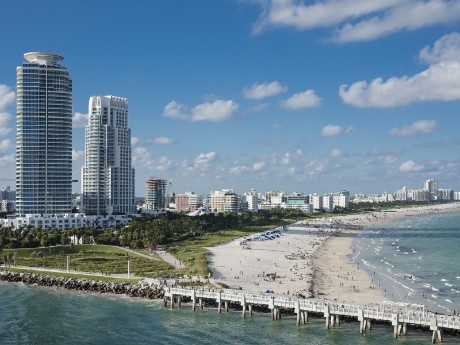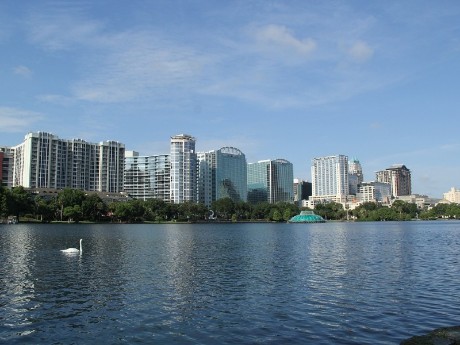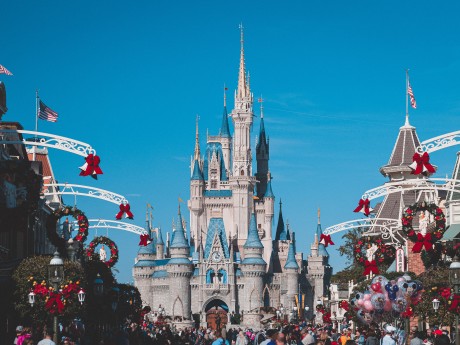USA: Florida-Miami & Orlando
Embark on a journey through Florida's vibrant cities, where you'll bask in the neon lights of Miami's Ocean Drive, revel in the pulsating nightlife. In Orlando, lose yourself in the enchanting world of Walt Disney World, where fairytales come to life and dreams take flight. Begin your journey in Miami, the Magic City, where you'll find stunning sunsets, vibrant nightlife, and South Beach's famous shoreline.
Read more
Embark on a journey through Florida's vibrant cities, where you'll bask in the neon lights of Miami's Ocean Drive, revel in the pulsating nightlife. In Orlando, lose yourself in the enchanting world of Walt Disney World, where fairytales come to life and dreams take flight. Begin your journey in Miami, the Magic City, where you'll find stunning sunsets, vibrant nightlife, and South Beach's famous shoreline. Explore Art Deco architecture and family-friendly museums like the Perez Art Museum and Miami Children's Museum. For a serene escape, head to Miami Beach or Key Biscayne for ocean views. As night falls, dive into the lively bar and club scene. In Orlando, dive into a world of thrills with iconic theme parks like Walt Disney World, Universal Studios, and SeaWorld. Beyond the parks, discover Gatorland's wildlife and the interactive exhibits at the Orlando Science Center. This trip seamlessly blends urban energy, beautiful beaches, thrilling attractions, and natural wonders, leaving you with cherished memories. Waterviews strives to offer accommodation options within walking distance of water and/or in an area of touristic interest. Our prices include taxes (but excludes local tourist taxes). Customize your trip to your personal preferences with optional activities (hit the “Add Activities’’) or change hotels, etc. Contact us for customization at no extra cost at: Service@waterviewstravel.com
Destinations
- Miami
- Orlando
Itinerary
Miami

Mesmerising Miami boasts beautiful beaches, glamorous streets and a warm and sunny climate. Spend the day soaking up the sun on the city’s famous white sand beach before dining in one of its excellent restaurants and experiencing the lively nightlife.
Read more
Mesmerising Miami boasts beautiful beaches, glamorous streets and a warm and sunny climate. Spend the day soaking up the sun on the city’s famous white sand beach before dining in one of its excellent restaurants and experiencing the lively nightlife.
Additional Information
History
Flagler’s railroad sparked a wave of expansion in areas such as Miami Beach, Homestead and Cutler. Soon after the railroad was built, the Overseas Highway was created. This highway connected the Florida Keys to the mainland. Growth and progress in Miami continued through World War I and into the mid-1920s.
A devastating hurricane in 1926 halted Miami’s growth and temporarily put the city and Miami Beach in a recession. It was the city’s support of President Franklin Delano Roosevelt’s New Deal that helped the city rebuild. Roosevelt almost lost his life, however, when Giuseppe Zangara attempted to assassinate Roosevelt when he came to Miami to thank the city for its support of the New Deal.
When a German U-boat sank a US tanker off Florida’s coast, the majority of South Florida was converted into military headquarters for the remainder of World War II. The Army’s World War II legacy in Miami is a school designed for anti-U-boat warfare.
Following the Cuban revolution, Miami has become a haven for Cuban immigrants. The city has also been the base for cocaine smuggling, depicted in the 1983 film Scarface, and the Miami Vice series.
Climate
Because of its proximity to the Tropic of Cancer, Miami's weather is generally hot. The summer months of June–September will see most daytime highs over 90°F (32°C). Combined with the region's humidity, these can make for stifling temperatures, both day and night. You won't see nearly a car or home without running air conditioning. Winters average an impressive 75°F (24°C) for daytime temperatures and nights are slightly cooler. During June to November, rain and thunderstorms can be expected and are most common in the afternoon hours. Rain is known to fall heavily for a few minutes, to stop entirely, and then to begin again. Knowing its mercurial nature, local residents often drive or go outside in rainy weather to enjoy its cooling effect or to make good use of breaks in the storm.
Information
Greater Miami and the Beaches Convention & Visitors Bureau, 27th floor of 701 Brickell Ave, +1 305 539-3000 – Open M-F 8:30AM-5PM.
© Sourced from Wikivoyage
Orlando

Most visitors have a specific reason for visiting Orlando: the infamous theme parks. The city welcomes millions each year to Disney World and Universal Orlando, and is teeming with energetic spirit which never seems to slow down. However, there is much more to be explored, from charming neighbourhoods with luscious green parks to the numerous museums sprinkled around the city and a developing art scene.
Read more
Most visitors have a specific reason for visiting Orlando: the infamous theme parks. The city welcomes millions each year to Disney World and Universal Orlando, and is teeming with energetic spirit which never seems to slow down. However, there is much more to be explored, from charming neighbourhoods with luscious green parks to the numerous museums sprinkled around the city and a developing art scene.
Additional Information
The Orlando area contains some of the world's largest and most famous theme park resorts. However, only one, Universal Orlando, is within the city limits. Walt Disney World and SeaWorld are in the immediate area, as are many of the more minor tourist attractions, and as Orlando is most associated with these popular attractions, you will find details and descriptions of them below.
History
Up until the Civil War, Orange County was widely considered a rural backwater. However, a Reconstruction-era boom in the area's population and the simultaneous growth of the citrus industry led to the establishment of the city of Orlando in 1885. Ten years later, the "Great Freeze" destroyed much of the citrus crop, forcing farmers to sell and the industry to shift southward.
Around the turn of the 19th century, Orlando became a somewhat popular resort city, and its downtown population grew during the Florida Land Boom of the 1920s. During World War II, the United States Air Force positioned a base in the city, and the military would go on to become Orlando's major industry through the 1950s and 1960s.
In 1965, Walt Disney went on television to announce his plans for "The Florida Project", possibly the most important moment in the city of Orlando's history. Walt Disney World opened in 1971 with one theme park – the Magic Kingdom – and the associated development and population explosion rocketed the city into what it is today. Over the subsequent years, tourism has further entrenched itself as the center of Orlando's economy. SeaWorld Orlando opened in 1973, and Epcot, the second Disney theme park, came in 1982. Disney's Hollywood Studios came in 1989, and Universal Studios Florida a year later. The Universal Orlando resort was born with the opening of the Islands of Adventure theme park in 1999, just a year after Disney's fourth park, Animal Kingdom, opened. Of course, with all of these parks came countless hotels, restaurants, and other tourist attractions spread across the city.
Talk
English is the primary language spoken in Orlando, but Spanish is spoken by a portion of the population as well. Due to the high number of international travelers coming to the city, nearly all of the theme parks and resorts, and many of the hotels and restaurants provide menus, guide maps, and other information in a variety of languages ranging from English and Spanish to French, Chinese, and Portuguese. Many attractions also employ bilingual or multilingual staff.
Orientation
Orlando sits nearly in the center of the state, about an hour's drive from both the Atlantic and Gulf coasts. North of downtown is the city of Winter Haven, with suburbs to the east and west. The entirety of the attractions area is southeast of the city center, with the airport nearby.
Climate
Many say Central Florida has two seasons: hot and hotter. Orlando has temperate winters affected by the occasional cold front; hot summers with daily thunderstorms; and warm, balmy springs and autumns. Spring in Orlando has highs in the 80s (27°C) in March & April transitioning to around 90°F (32°C) in May and the low to mid-90s in June. Spring is the driest time of year, and in the past decade some spring months have seen less than a half-inch of rain. This is the time of year in which many small wildfires appear around the region, but this should not affect anyone who stays in the urban areas. March and April are great times to visit with dry days, clear skies, and warm temperatures with no cold fronts. In comparison, late May and early June are arguably the worst time to visit, filled with hot, humid, dry days. Summer brings daily thunderstorms starting in June. Highs from mid-June to mid-September are in the mid 90s, with 90°F (32°C) often being reached by 10 or 11AM, and lows in the 70s (23°C). Due to Orlando's proximity to two coasts, thunderstorms form everyday in the summer from the humid ocean breezes that cross over land and heat up. Sometimes violent thunderstorms occur, see the "Stay Safe" section. After passing, they will often drop temperatures into the low 80s (28°C), a welcome relief from the hot temperatures earlier in the day. Autumn varies much more from year-to-year than spring. The daily thunderstorms taper off in September, leaving highs in the mid to upper 80s (29°C) until mid-October. The first cold front of the season will usually pass by late October, plunging highs into the 70s (24°C) and lows into the 50s (12°C) and upper 40s (10°C). The cooling trend continues into November and December, with highs falling into the 70s (24°C) by late December and lows into the 50s (12°C). These temperatures can be affected by the occasional cold front, which can plunge highs into the 60s (18°C) and 50s (12°C) and lows into the 40s (7°C) and as low as freezing (32°F/0°C) by mid-December. Winter is much the same as November and December. Highs are in the 70s (24°C), lows in the 50s (12°C), affected every week or two by cold fronts. With those fronts, highs can drop into the 50s (12°C) and lows into the 30s (2°C). Sub-freezing mornings typically occur two or three times a year.
Most tourists visit Orlando for summer vacations between June and August, or for spring breaks in March and April. Ironically, the less busy times for tourism correspond to the best weather in the Orlando area. Visiting when the weather isn't so hot means fewer people in the area, with emptier parks and more comfortable weather.
© Sourced from Wikivoyage





